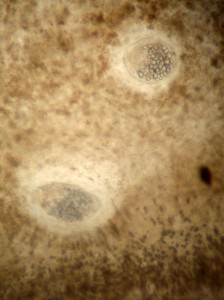by Katrina Lohan
In addition to taking oyster tissue to test for the presence of protistan parasites, we are also analyzing the oyster tissue for larger, but still microscopic, parasitic species such as worms, trematodes, and copepods. We have found parasites in all the species examined in all the locations we have traveled, but I got the best pictures of critters observed in oysters in Florida!The highest prevalence and density of parasites occurred in Crassostrea virginica oysters. So far, I have seen copepods, turbellarians (probably Urostoma sp.), pea crabs, gill parasites, and cysts (probably from cestodes). I even saw what looked like a fish embryo, which was probably just brought into the gills, and an insect larva. Seeing all these critters under the microscope has made me contemplate why oysters are considered an aphrodisiac!


